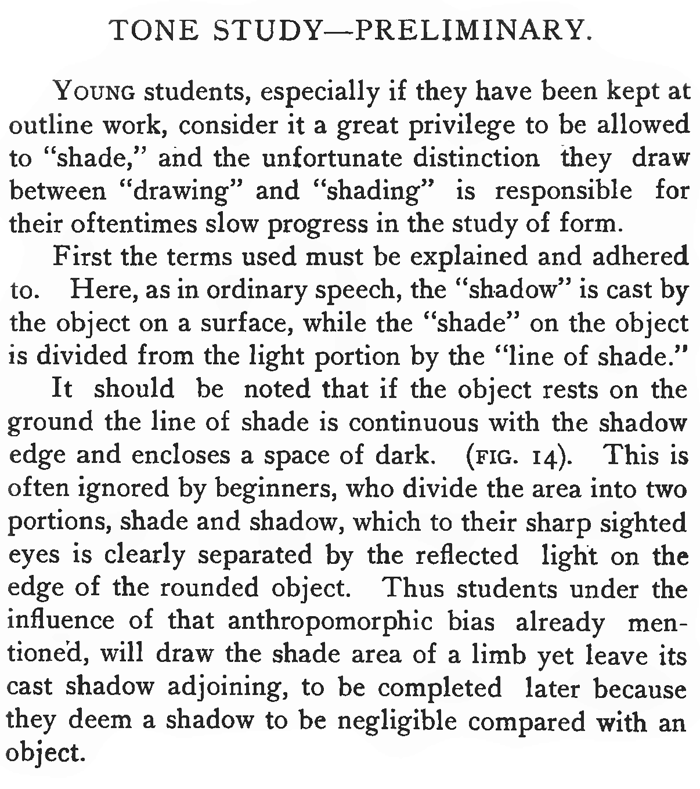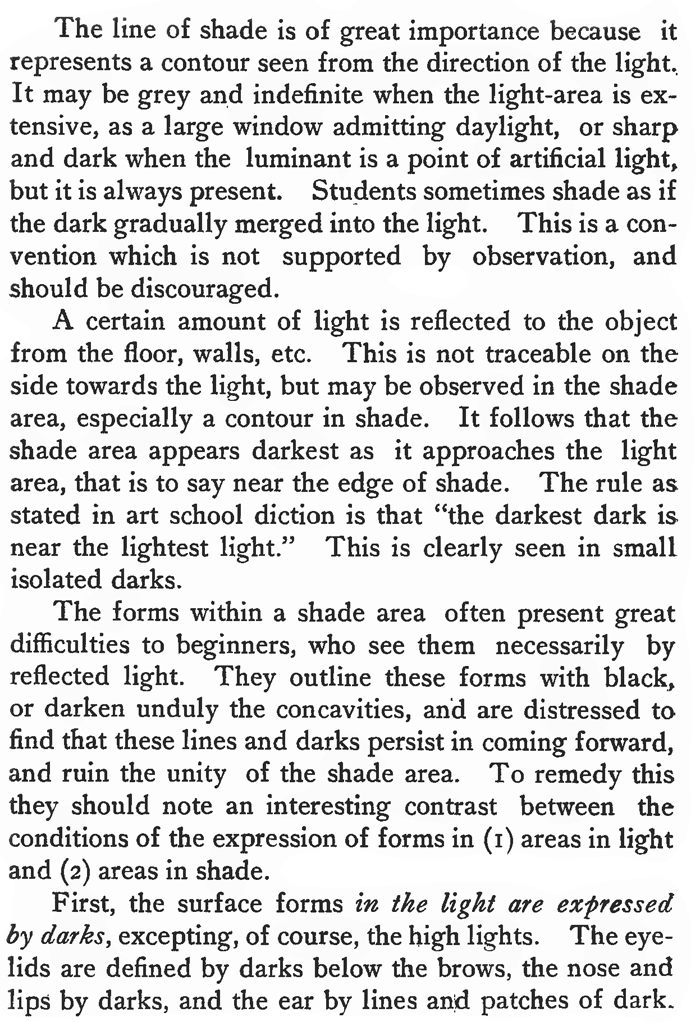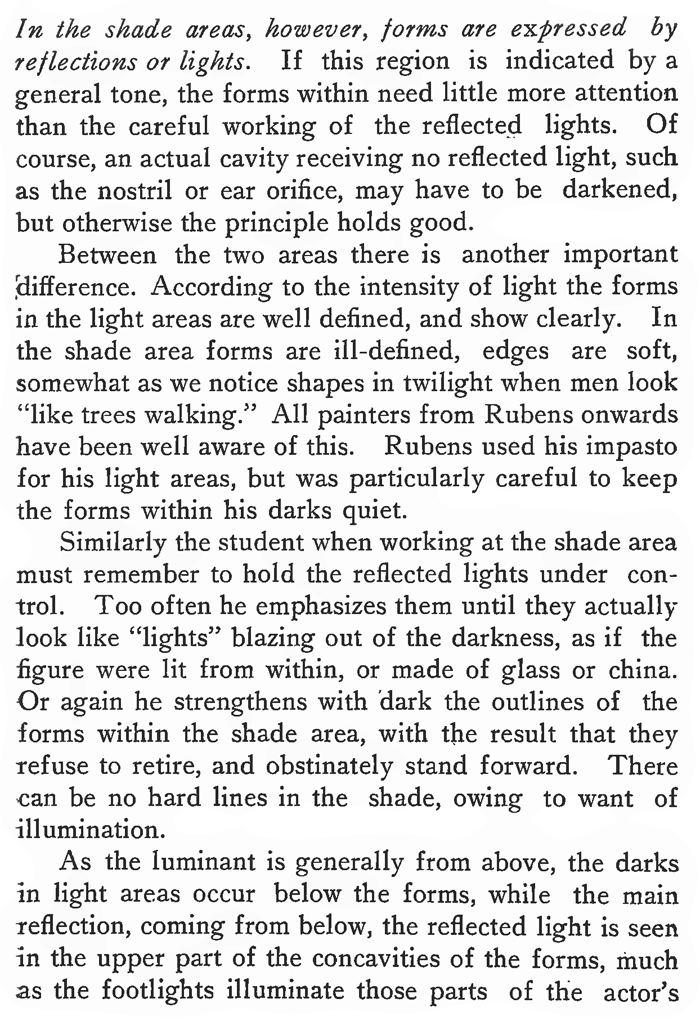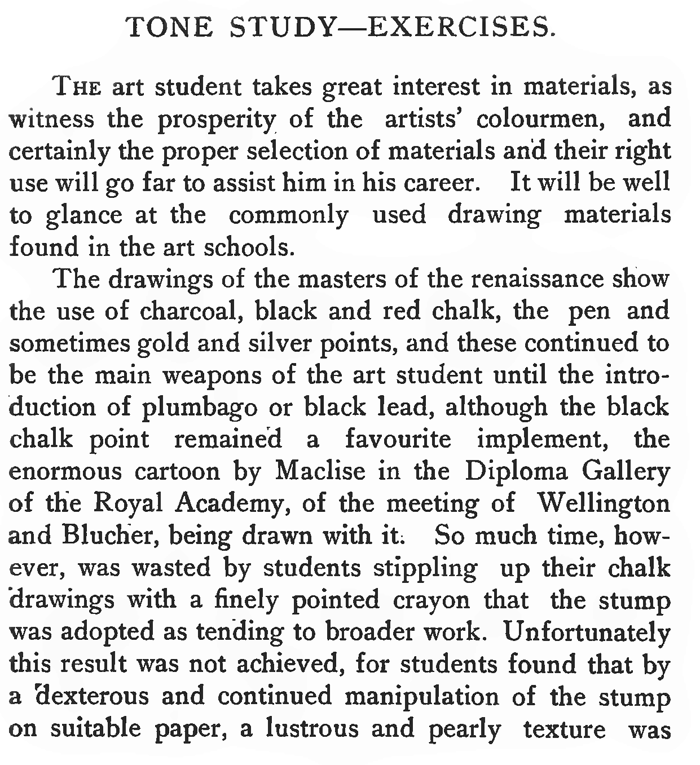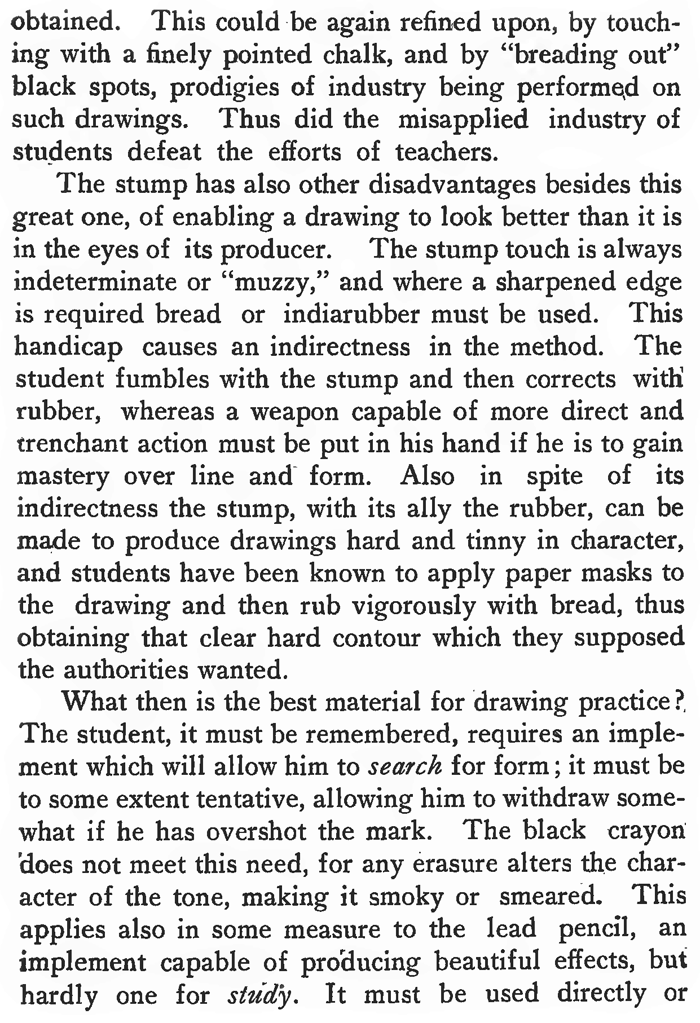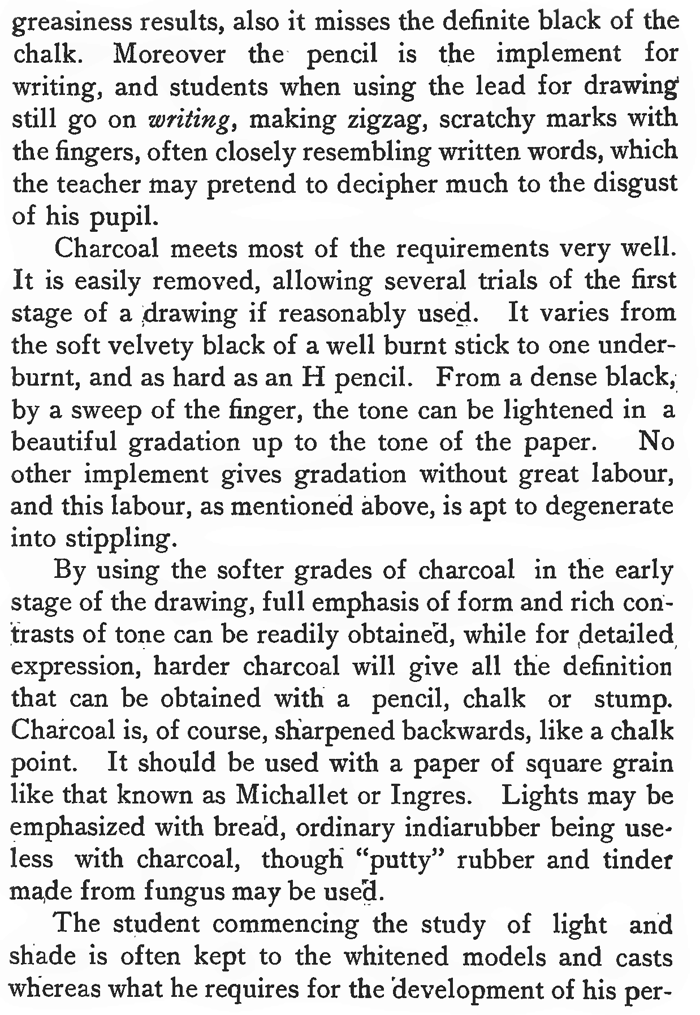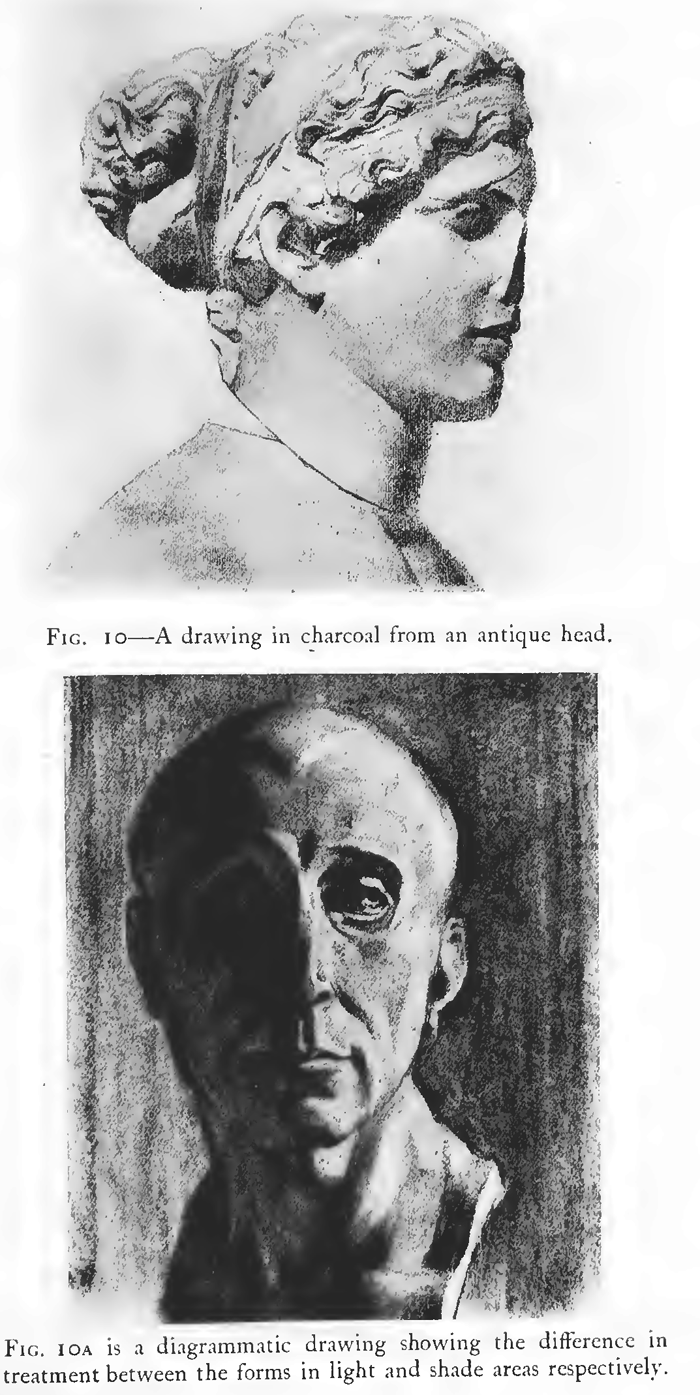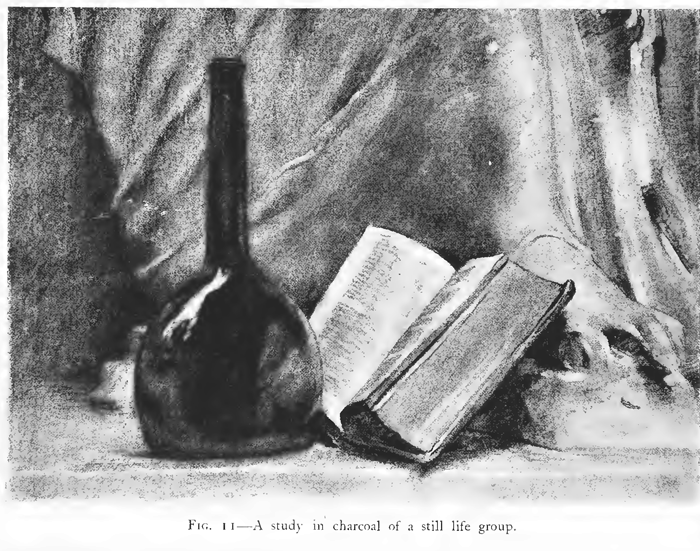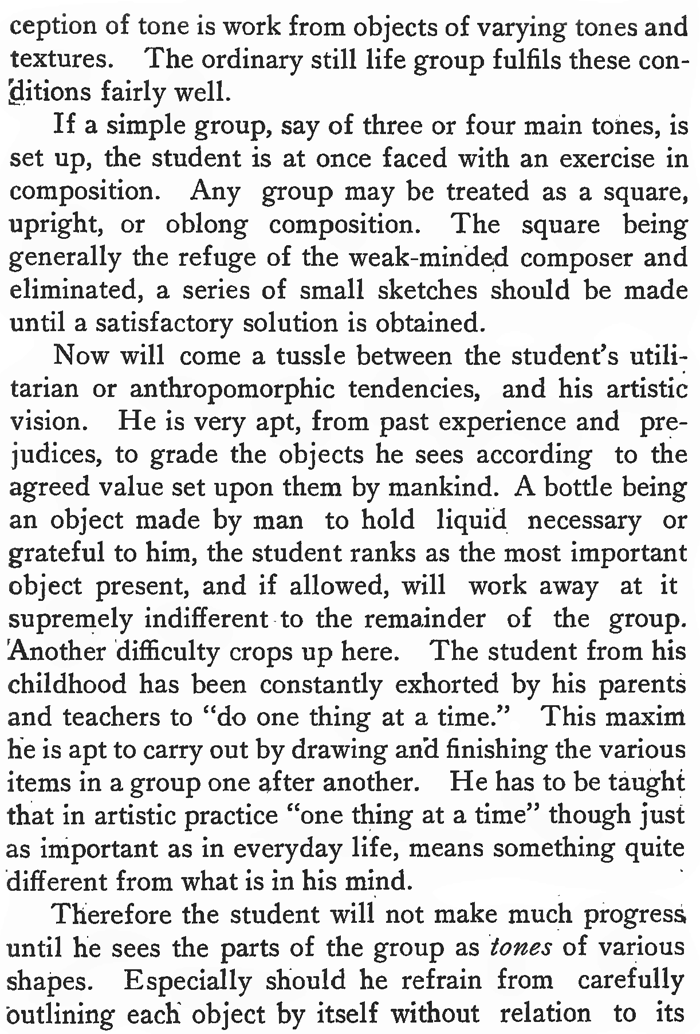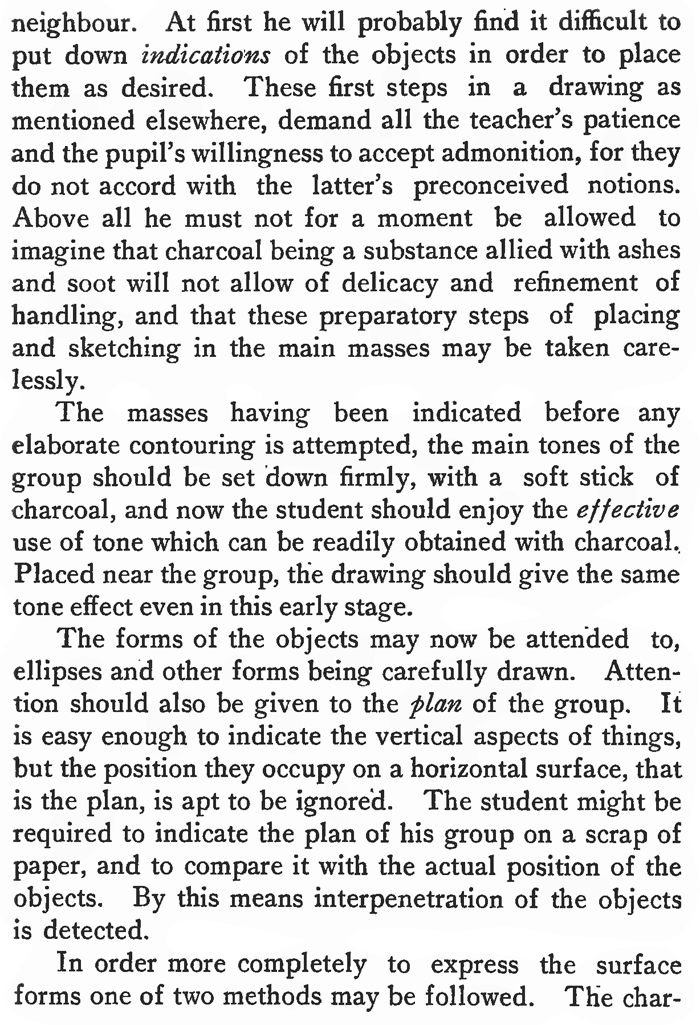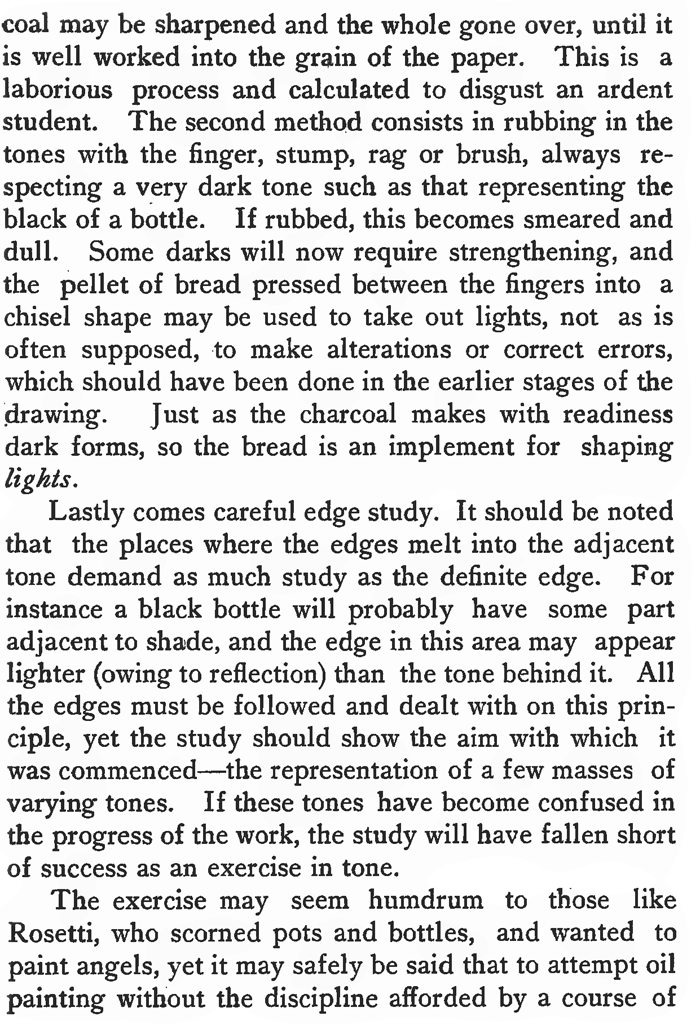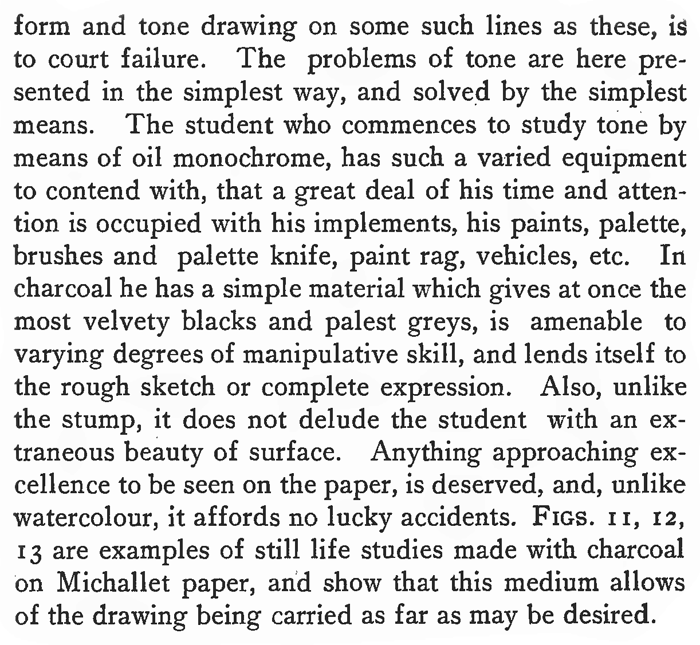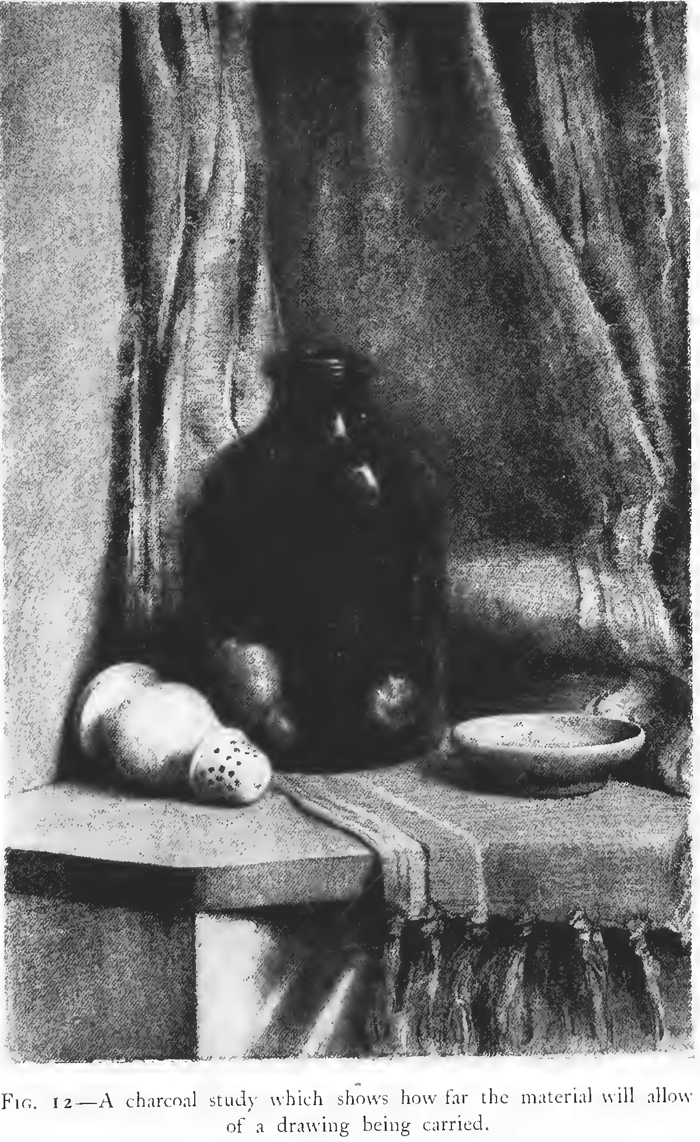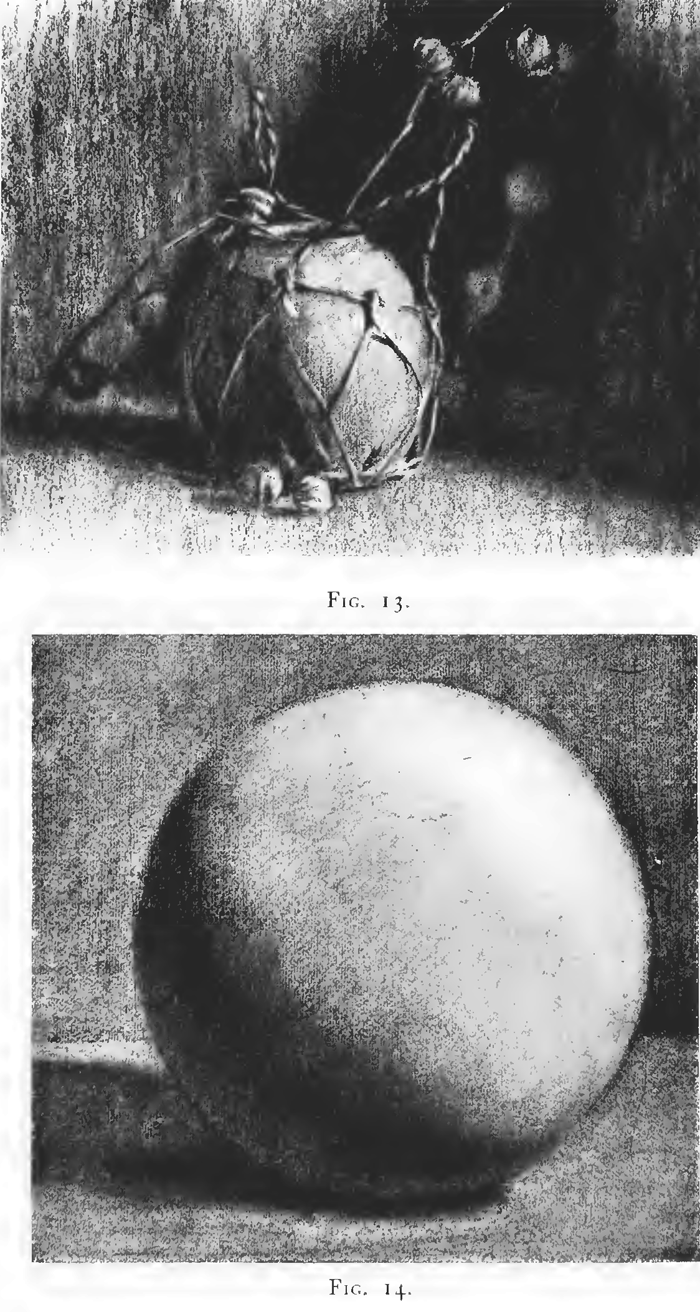Home > Directory of Drawing Lessons > How to Improve Your Drawings > Adding Tones and Values > Tones Study and Exercises
Learn About Tones & Shading of Tones by Doing the following Studies and Exercises for Beginners
|
|
The text above is made up of images, to copy some text, it is below. TONE STUDY—PRELIMINARY.Young students, especially if they have been kept at outline work, consider it a great privilege to be allowed to "shade," and the unfortunate distinction they draw between "drawing" and "shading" is responsible for their oftentimes slow progress in the study of form. First the terms used must be explained and adhered to. Here, as in ordinary speech, the "shadow" is cast by the object on a surface, while the "shade" on the object is divided from the light portion by the "line of shade." It should be noted that if the object rests on the ground the line of shade is continuous with the shadow edge and encloses a space of dark. (FIG. 14). This is often ignored by beginners, who divide the area into two portions, shade and shadow, which to their sharp sighted eyes is clearly separated by the reflected light on the edge of the rounded object. Thus students under the influence of that anthropomorphic bias already mentioned, will draw the shade area of a limb yet leave its cast shadow adjoining, to be completed later because they deem a shadow to be negligible compared with an object. The line of shade is of great importance because it represents a contour seen from the direction of the light.. It may be gray and indefinite when the light-area is extensive, as a large window admitting daylight, or sharp and dark when the luminant is a point of artificial light, but it is always present. Students sometimes shade as if the dark gradually merged into the light. This is a convention which is not supported by observation, and should be discouraged. A certain amount of light is reflected to the object from the floor, walls, etc. This is not traceable on the side towards the light, but may be observed in the shade area, especially a contour in shade. It follows that the shade area appears darkest as it approaches the light area, that is to say near the edge of shade. The rule as stated in art school diction is that "the darkest dark is near the lightest light." This is clearly seen in small isolated darks. The forms within a shade area often present great difficulties to beginners, who see them necessarily by reflected light. They outline these forms with black, or darken unduly the concavities, and are distressed to find that these lines and darks persist in coming forward, and ruin the unity of the shade area. To remedy this they should note an interesting contrast between the conditions of the expression of forms in (I) areas in light and (2) areas in shade. First, the surface forms in the light are expressed by darks, excepting, of course, the high lights. The eyelids are defined by darks below the brows, the nose and lips by darks, and the ear by lines and patches of dark. In the shade areas, however, forms are expressed by reflections or lights. If this region is indicated by a general tone, the forms within need little more attention than the careful working of the reflected lights. Of course, an actual cavity receiving no reflected light, such as the nostril or ear orifice, may have to be darkened, but otherwise the principle holds good. Between the two areas there is another important difference. According to the intensity of light the forms in the light areas are well defined, and show clearly. In the shade area forms are ill-defined, edges are soft, somewhat as we notice shapes in twilight when men look "like trees walking." All painters from Rubens onwards have been well aware of this. Rubens used his impasto for his light areas, but was particularly careful to keep the forms within his darks quiet. Similarly the student when working at the shade area must remember to hold the reflected lights under control. Too often he emphasizes them until they actually look like "lights" blazing out of the darkness, as if the figure were lit from within, or made of glass or china. Or again he strengthens with 'dark the outlines of the forms within the shade area, with the result that they refuse to retire, and obstinately stand forward. There can be no hard lines in the shade, owing to want of illumination. As the luminant is generally from above, the darks in light areas occur below the forms, while the main reflection, coming from below, the reflected light is seen in the upper part of the concavities of the forms, much as the footlights illuminate those parts of the actor's features. Figure. IOA shows the general principle of working both light and dark areas. The drawing was made by artificial light. TONE STUDY—EXERCISES.The art student takes great interest in materials, as witness the prosperity of the artists' colourmen, and certainly the proper selection of materials and their right use will go far to assist him in his career. It will be well to glance at the commonly used drawing materials found in the art schools. The drawings of the masters of the renaissance show the use of charcoal, black and red chalk, the pen and sometimes gold and silver points, and these continued to be the main weapons of the art student until the introduction of plumbago or black lead, although the black chalk point remained a favorite implement, the enormous cartoon by Maclise in the Diploma Gallery of the Royal Academy, of the meeting of Wellington and Blucher, being drawn with it. So much time, however, was wasted by students stippling up their chalk drawings with a finely pointed crayon that the stump was adopted as tending to broader work. Unfortunately this result was not achieved, for students found that by a 'dexterous and continued manipulation of the stump on suitable paper, a lustrous and pearly texture was obtained. This could be again refined upon, by touching with a finely pointed chalk, and by "breading out" black spots, prodigies of industry being performed on such drawings. Thus did the misapplied industry of students defeat the efforts of teachers. The stump has also other disadvantages besides this great one, of enabling a drawing to look better than it is in the eyes of its producer. The stump touch is always indeterminate or "muzzy," and where a sharpened edge is required bread or india rubber (eraser) must be used. This handicap causes an indirectness in the method. The student fumbles with the stump and then corrects with rubber, whereas a weapon capable of more direct and trenchant action must be put in his hand if he is to gain mastery over line and form. Also in spite of its indirectness the stump, with its ally the rubber, can be made to produce drawings hard and tinny in character, and students have been known to apply paper masks to the drawing and then rub vigorously with bread, thus obtaining that clear hard contour which they supposed the authorities wanted. What then is the best material for drawing practice? The student, it must be remembered, requires an implement which will allow him to search for form ; it must be to some extent tentative, allowing him to withdraw somewhat if he has overshot the mark. The black crayon does not meet this need, for any erasure alters the character of the tone, making it smoky or smeared. This applies also in some measure to the lead pencil, an implement capable of producing beautiful effects, but hardly one for shay. It must be used directly or greasiness results, also it misses the definite black of the chalk. Moreover the pencil is the implement for writing, and students when using the lead for drawing still go on writing, making zigzag, scratchy marks with the fingers, often closely resembling written words, which the teacher may pretend to decipher much to the disgust of his pupil. Charcoal meets most of the requirements very well. It is easily removed, allowing several trials of the first stage of a drawing if reasonably used. It varies from the soft velvety black of a well burnt stick to one under-burnt, and as hard as an H pencil. From a dense black, by a sweep of the finger, the tone can be lightened in a beautiful gradation up to the tone of the paper. No other implement gives gradation without great labor, and this labor, as mentioned above, is apt to degenerate into stippling. By using the softer grades of charcoal in the early stage of the drawing, full emphasis of form and rich contrasts of tone can be readily obtained, while for ,detailed, expression, harder charcoal will give all the definition that can be obtained with a pencil, chalk or stump. Charcoal is, of course, sharpened backwards, like a chalk point. It should be used with a paper of square grain like that known as Michallet or Ingres. Lights may be emphasized with bread, ordinary india rubber (eraser) being useless with charcoal, though "putty" rubber and tinder made from fungus may be used. FIG. 10 —A drawing in charcoal from an antique head. FIG. 1OA is a diagrammatic drawing showing the difference in treatment between the forms in light and shade areas respectively. FIG. 11-A study in charcoal of a still life group. If a simple group, say of three or four main tones, is set up, the student is at once faced with an exercise in composition. Any group may be treated as a square, upright, or oblong composition. The square being generally the refuge of the weak-minded composer and eliminated, a series of small sketches should be made until a satisfactory solution is obtained. Now will come a tussle between the student's utilitarian or anthropomorphic tendencies, and his artistic vision. He is very apt, from past experience and prejudices, to grade the objects he sees according to the agreed value set upon them by mankind. A bottle being an object made by man to hold liquid, necessary or grateful to him, the student ranks as the most important object present, and if allowed, will work away at it supremely indifferent to the remainder of the group. Another difficulty crops up here. The student from his childhood has been constantly exhorted by his parents and teachers to "do one thing at a time." This maxim he is apt to carry out by drawing and finishing the various items in a group one after another. He has to be taught that in artistic practice "one thing at a time" though just as important as in everyday life, means something quite different from what is in his mind. Therefore the student will not make much progress until he sees the parts of the group as tones of various shapes. Especially should he refrain from carefully outlining each object by itself without relation to its neighbor. At first he will probably find it difficult to put down indications of the objects in order to place them as desired. These first steps in a drawing as mentioned elsewhere, demand all the teacher's patience and the pupil's willingness to accept admonition, for they do not accord with the latter's preconceived notions. Above all he must not for a moment be allowed to imagine that charcoal being a substance allied with ashes and soot will not allow of delicacy and refinement of handling, and that these preparatory steps of placing and sketching in the main masses may be taken carelessly. The masses having been indicated before any elaborate contouring is attempted, the main tones of the group should be set down firmly, with a soft stick of charcoal, and now the student should enjoy the effective use of tone which can be readily obtained with charcoal. Placed near the group, the drawing should give the same tone effect even in this early stage. In order more completely to express the surface forms one of two methods may be followed. The charcoal may be sharpened and the whole gone over, until it is well worked into the grain of the paper. This is a laborious process and calculated to disgust an ardent student. The second method consists in rubbing in the tones with the finger, stump, rag or brush, always respecting a very dark tone such as that representing the black of a bottle. If rubbed, this becomes smeared and dull. Some darks will now require strengthening, and the pellet of bread pressed between the fingers into a chisel shape may be used to take out lights, not as is often supposed, to make alterations or correct errors, which should have been done in the earlier stages of the drawing. Just as the charcoal makes with readiness dark forms, so the bread is an implement for shaping lights. Lastly comes careful edge study. It should be noted that the places where the edges melt into the adjacent tone demand as much study as the definite edge. For instance a black bottle will probably have some part adjacent to shade, and the edge in this area may appear lighter (owing to reflection) than the tone behind it. All the edges must be followed and dealt with on this principle, yet the study should show the aim with which it was commenced—the representation of a few masses of varying tones. If these tones have become confused in the progress of the work, the study will have fallen short of success as an exercise in tone. The exercise may seem humdrum to those like Rosetti, who scorned pots and bottles, and wanted to paint angels, yet it may safely be said that to attempt oil painting without the discipline afforded by a course of form and tone drawing on some such lines as these, is to court failure. The problems of tone are here presented in the simplest way, and solved by the simplest means. The student who commences to study tone by means of oil monochrome, has such a varied equipment to contend with, that a great deal of his time and attention is occupied with his implements, his paints, palette, brushes and palette knife, paint rag, vehicles, etc. In charcoal he has a simple material which gives at once the most velvety blacks and palest grays, is amenable to varying degrees of manipulative skill, and lends itself to the rough sketch or complete expression. Also, unlike the stump, it does not delude the student with an extraneous beauty of surface. Anything approaching excellence to be seen on the paper, is deserved, and, unlike watercolor, it affords no lucky accidents. FIGS. 11, 12, 13 are examples of still life studies made with charcoal on Michallet paper, and show that this medium allows of the drawing being carried as far as may be desired. Figure 12 —A charcoal study which shows how far the material will allow of a drawing being carried. |
Privacy Policy ...... Contact Us





